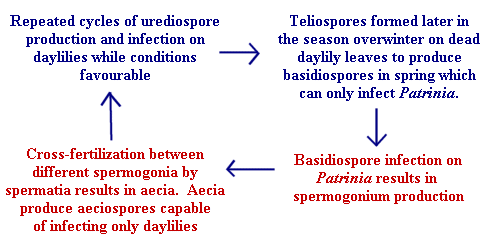The Life Cycle of Puccinia hemerocallidisRust on daylilies is a complex disease which goes through several different life cycle stages.
Part of the life cycle takes place on daylilies and part on another Asian
perennial plant known as Patrinia. A diagram of the life cycle appears below with the stages on daylily in blue, and those on Patrinia in red. A more detailed (but still somewhat simplified) description of the different stages follows the diagram.
 On daylilies, the rust produces two spore types, urediospores and teliospores. A spore is a reproductive unit capable of germination and growth, somewhat similar to a plant seed. The repetition of infection on daylilies by urediospores alone is an asexual (cloning) method of reproduction which serves to build up the level of disease. The rust also has a form of sexual reproduction which cannot be completed without the alternate host, Patrinia. Both hosts are needed to fully complete the life cycle of this rust, although the rust can overwinter without the sexual cycle where conditions permit.
Note: Rusts are "obligate parasites" which means that their mycelium can only grow and feed in living plant tissue. The spores, on the other hand, can live independently of live plants for varying periods of time. The longevity of the different spore types of daylily rust is not yet known. In order to germinate and infect, however, urediospores, basidiospores and aeciospores must land on living plant parts and experience suitable conditions of moisture and temperature. In contrast, teliospores do not need living tissue on which to germinate and produce basidiospores. Only urediospores and teliospores have been reported since the rust was first identified in North America in August 2000, there have been no reports of infected Patrinia plants in North America. However, Puccinia hemerocallidis was first recorded in 1880 in Siberia, Russia, and the spermogonial/aecial stage on Patrinia and its relationship to rust on daylilies has been documented in both Russia (Tranzschel, 1913)1 and Japan (Hiratsuka, 1938)1 as well as more recently in Japan (Ono, 2003)2. 1Hiratsuka, N., Sato, T., Katsuya, K., Kakishima, M., Hiratsuka, Y., Kaneko, S., Ono, Y., Sato, S., Harada, Y., Hiratsuka, T., and Nakayama, K. 1992. The Rust Flora of Japan. Tsukuba Shuppankai, Ibaraki, Japan. Pages 710-711. 2Ono, Y. 2003. Does Puccinia hemerocallidis regularly host-alternate between Hemerocallis and Patrinia plants in Japan? J Gen Plant Pathol 69:240-243.
©2002-14 Susan Bergeron. |